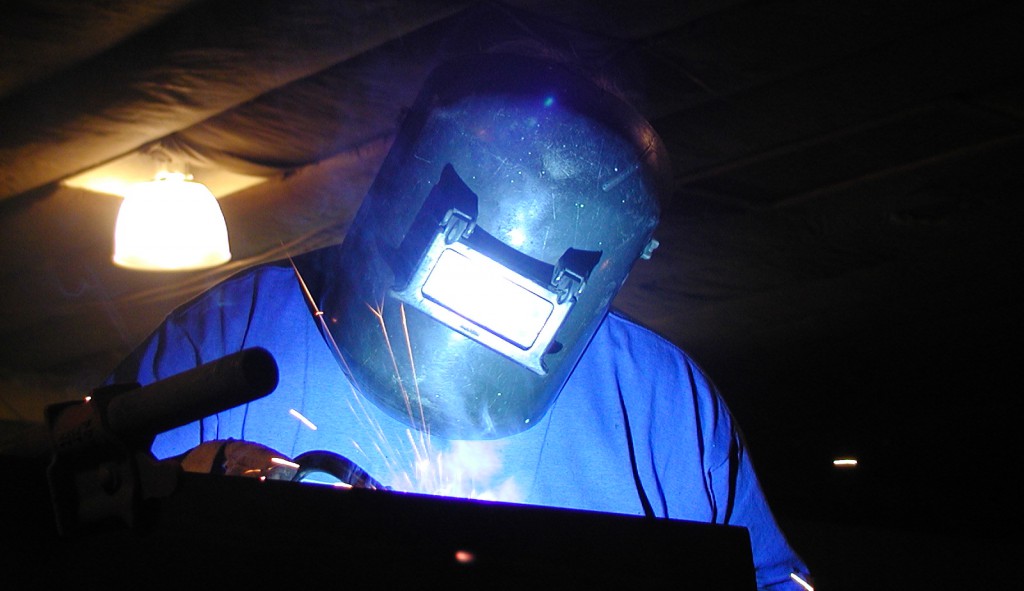The article will cover the basics of welding stainless steel tube and pipe for applications ranging from high-purity food and beverage, pharmaceutical and petrochemical pipe to oil and gas applications. Presented best practices and new wrinkles on established methods are within these basics that may help drive productivity in your shop while improving or maintaining the desired corrosion resistance.
As a note: Critical applications where processes are certified should not be altered without going through appropriate certification processes. Each process detailed in this article has been certified in critical applications and the intent is to spur ideas as to how to move your own welding practices forward.
Filler Metal Selection is Critical in Controlling Carbon Levels
Selecting filler metal for stainless steel pipe is about enhancing the properties of the weld and meeting the requirements of the application. Filler metals with an “L” designation, such as ER308L, provide a lower maximum carbon content, which can assist with retaining corrosion resistance in low-carbon alloys. For example, if you weld a 304L base metal with a standard 308 filler metal, you will actually raise the carbon content of that joint and increase the chance of corrosion. In high-purity applications — food, beverage, pharmaceutical — that low carbon content is crucial for maintaining corrosion resistance.
Conversely, a filler metal with an “H” designation provides higher carbon content for applications requiring greater strength, particularly at high temperatures. Filler metals with higher silicon levels, such as ER309LSi, increase weld pool fluidity, improve tie-ins, and increase travel speeds for greater productivity. The 309 series filler metals are also particularly adept at joining dissimilar stainless steels and in overlay applications.
It’s also important to select a filler metal with low trace (or “tramp”) elements when welding stainless steels. These are residual elements in the raw materials used to make filler metals. They include tin, antimony, arsenic, phosphorus and sulfur, and can have strong effects on corrosion resistance.
Controlling Sensitization with Filler Metals, Interpass Temperature Control
The primary cause of the loss of corrosion resistance is sensitization, and is affected by the chemistry of the base material and filler material, as well as the temperatures at which the weld cools. The “stainless” layer of stainless steel is chromium oxide. If you raise the carbon levels in the weld and neighboring heat-affected zone (HAZ), it forms chromium carbides, which tie up the chromium, preventing the formation of chromium oxide. In turn, this allows the steel to corrode or it will not have the intended corrosion resistance.
There are three primary ways to combat sensitization. The first is to use a low carbon base and filler metal to reduce or eliminate carbon in the welding application. However, this method is not always practice since carbon is a vital alloying ingredient in some applications.
The second is to minimize the time the weld and HAZ spend at temperatures conducive to sensitization. Depending on whom you ask, that range will vary, but a general consensus puts that range between 500° and 800°C. The less time spent in that temperature zone, the less damage that accrues from the heat of welding. As such, it is essential to adhere to maximum interpass temperatures identified in welding procedures. The goal in multipass applications should be to use as few passes as possible and weld at the lowest heat input possible to achieve faster cooling.
The third is to use filler metals containing special alloying ingredients to prevent the formation of chromium carbides. For example, titanium and niobium can be alloyed into the filler metal to help prevent reactions between chromium and carbon. These elements also have strong effects on strength and toughness, limiting the applications in which they are useful. They also do not provide any benefit to the areas farthest away from the weld in the HAZ.
Shielding Gas is Critical in Retaining Containing
Traditionally, welding stainless steel tube and pipe requires a backpurge of argon. In noncritical applications, where cost is a driving factor, nitrogen can also be used as a backpuge, but it may lead to the formation of some nitride compounds in the weld root, which sacrifices some corrosion resistance. This can be an acceptable trade-off in applications such as stainless steel piping for large compressed air systems and hydraulic fluid systems where water is not normally present inside the pipes and the risk of corrosion from the inside is low.
It is recommended to use straight argon for gas tungsten arc welding (GTAW) of stainless steel tube and pipe. Shielding gas selection for wire processes is more complicated.
Gas metal arc welding (GMA) has traditionally relied on mixtures of argon and carbon dioxide, argon and oxygen, and three gas mixtures based on helium, argon, and carbon dioxide. Usually, these mixes consist mostly of argon or helium, with carbon dioxide comprising less than 5% of the total gas mix. This is because the carbon dioxide can decompose in the arc and contribute carbon to the weld pool, creating a sensitizes weld that is vulnerable to corrosion. Pure argon is not used with the GMAW process because it doesn’t easily support a stable welding arc. Other trace constituents such as carbon dioxide and oxygen can serve this role. Argon and oxygen gas mixes can only be used to weld in the flat position because the oxygen makes for a very fluid molten weld pool. Argon/carbon dioxide in combination with pulsed GMAW can be used to weld in all positions, as can the tri-mix shielding gas mixtures.
Flux-cored wires for welding stainless steel are designed to run on traditional 75/25% argon/carbon dioxide mixes. The flux ingredients prevent the carbon contributed by the shielding gas from contaminating the weld, and the fluxing action of the slag covering scavenges the excess carbon and keeps it from entering the weld deposit.
Additionally, 304 stainless steel can be successfully welded using the Regulated Metal Deposition (RMDTM) process without a backpurge. This is not the case for duplex stainless steels. These must be purged with an inert gas such as argon.
Weld Preparation and the Importance of Fitup
A discussion on welding stainless steel tube and pipe is not complete without a discussion on joint preparation. The normal trappings of welding stainless steel apply: Use dedicated brushes, files and grinders that never touch carbon steel or aluminum.
Cleanliness is critical. Even trace elements of foreign materials incorporated into the weld joint can cause flaws and lead to reduced corrosion resistance and strength. Because stainless steel is so sensitive to heat input to maintain its properties — both in shape and corrosion resistance — the way the pipe is cut and beveled can also have a detrimental effect on the weld. Any gap or lack of fitup requires the welder to add more filler metal and cal slow the welding process down, leading to buildup of heat in the affected area. You want as close to perfect fitup as possible, especially on sanitary and high-purity tubing.
Controlling Heat Input and Speed Drives Process Evolution
The welding process itself also plays a crucial role in controlling heat input and cooling, and thereby corrosion resistance and distortion.
Traditionally, gas tungsten arc welding is used for welding stainless steel tube and pipe, and remains the optimal solution for extremely high-purity applications on tube or pipe at or below 6 inches in diameter and Schedule 10 wall thickness. The preferred method for high-purity, food-grade stainless steel is an autogenous GTAW square butt joint weld. The ability to fuse the pipe without adding any filler metal assists with keeping heat down and eliminates any chemistry changes that could be created by the added filler metal. Typically, this practice works on any tube or pipe thinner than 1/8 inches thick. As the pipe gets thicker, in the Schedule 10 to 40 range, then it becomes necessary to bevel the pipe and add filler metal. There are some smaller-diameter pipes with thicker walls, such as 2-inch-diameter Schedule 80, where GTAW remains ideal because switching to a wire process on small pipe diameters isn’t practical.
GTAW inverters today perform this application extremely well, as the pulsing capabilities have improved substantially since the days of the larger transformer-based machines and help to keep heat input down. Older GTAW technology is limited to pulsing at about 20 pulses/s. Newer GTAW inverter technology, such as the Maxstar 200, allows highspeed DC GTAW pulsing up to 500 pulses/s. Having the ability to control pulsing up to that range allows the welder to reduce the average amperage and heat input significantly, thereby helping to control penetration and reduce distortion. Pulsing at these higher frequencies increases the arc focus by pulsing quickly between a high peak and low background current, allowing you to get more penetration, move faster and reduce the HAZ. Tests have shown that pulsing between 250 and 400 pulses/s increases travel speed up to 35% without sacrificing any weld penetration.
GMAW Processes Evolve and Simplify Stainless Steel Pipe Fabrication
While thicker, high-purity pipe applications that still require a GTAW root and/or a GTAW hot pass remain, GMAW root passes on stainless steel are regularly certified in less critical applications and, in some instances, more critical applications traditionally perfomred with GTAW. Some applications are even being completed without the assistance of a backpurge, a relatively recent development made possible with a modified short circuit GMAW process such as RMD available with the PipeWorx pipe welding system. However, it should never be done in high-purity applications with duplex stainless steels such as pharmaceutical, semiconductor, or food processing.
A common welding sequence on a larger diameter pipe, such as a 12 inch Schedule 40 pipe used in oil and gas processing, would be to lay an RMD root and then switch to a pulsed GMAW (using the same shielding gas and wire as the root pass) or flux cored arc welding process for the fill and cap passes, which eliminates the need for a GTAW hot pass.
A modified short circuit GMAW process presents an improvement over traditional short-circuit GMAW in that the welding system anticipates and controls the short circuit, then reduces the welding current to create a consistent metal transfer. Precisely controlled metal transfer provides uniform droplet deposition and makes it easier for the welder to control the pool and, thus, heat input and welding speeds. The smooth metal transfer compensates for a high-low misalignment between pipe sections, forgiving imperfect pipe fitup in some applications and creating more consistent root reinforcement on the inside of the pipe.
Similarly, the shielding gas comes out of the gun relatively undisturbed by the controlled transfer and gets pushed through the root opening to prevent oxidation on the backside. This feature has allowed pipe fabricators to certify processes without a backing gas in some austenitic stainless applications, eliminating the considerable time and cost associated with backpuring larger pipes.
A modified short circuit GMAW process is also easier to train new welders to use as the controlled metal transfer makes for an easier-to-control weld pool. The process maintains a consistent arc length regardless of electrode extension and enables a good view of the weld pool. These features take training on a historically difficult application from weeks down to a matter of days.
This process allows pipe fabricators to increase their speed and productivity without putting extra heat into the part, helping to maintain the corrosion resistance and mechanical properties provided by stainless steel. Welding speeds with this modified short-circuit process range from 6 to 12 inches/minute vs. 3 to 5 inches/minute with GTAW. That speed increase, in addition to the ability to eliminate the GTAW hot pass and potentially eliminate the backing gas in some applications, provides significant savings in time and cost.
The reduced heat input also assists with distortion on stainless steel compared to other GMAW processes. Some companies report being able to take pipe fabrication processes that were previously modular — assembling in pieces and then bringing together later for full assembly to control heat input — and fabricate the whole structure now in one sitting because of the lower heat input and reduced distortion. This simplifies the process and allows it to come together more quickly, thus significantly reducing labor hours.
Source: aws.org


